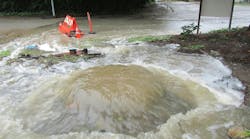Employing GreenScapes and Green Building
Urban development and the resulting decline in soil quality have had profound influences on both air and water quality throughout the U.S. Interest and concern have been growing about the poor quality of soils that follow disturbance from development and the resulting loss of environmental functions that native soils and their related vegetation systems typically provide.
Conventional storm water systems using end-of-pipe technology have on many occasions failed to control peak flow rates and volume associated with impervious surfaces. Excessive runoff resulting from impervious surfaces has aggravated flooding, reduced infiltration and groundwater base flows, contaminated receiving water and drinking water supplies and caused erosion and habitat destruction.
Too often the decline in soil quality has been viewed in isolation from the decline in water quality. For progress to be made in improving water quality and quantity, it must first be recognized that nearly every drop of water in our rivers, lakes, estuaries and aquifers has either traveled through the soil or flowed over its surface. The decline and degradation of soil and its related vegetative systems start a chain reaction with profound consequences for water. Water loss, utilization, contamination and purification are all affected by the soil.
One significant function of the soil and its related vegetation is water storage. Storage of water in the soil reduces surface runoff and erosion and retains water onsite for infiltration and use by soil microorganisms and plant life. Other important functions of the soil are the cleansing of water and the binding of chemicals that on many occasions become water pollutants.
These functions are largely lost during land-development activities where native soils and vegetation are stripped away, surface area is compacted and minimal amounts of topsoil and sod are used as a final vegetative cover. Not only are important storm water functions lost, but these newly constructed, nearly impervious landscapes themselves become pollutant-generating devices requiring considerable amounts of water, fertilizer and pesticide for sustainment. Because topsoil is a finite natural resource that does not develop or replenish quickly, the manufacturing of soils using quality compost is a practical and necessary alternative to stripped topsoil.
Organic matter
The role organic matter plays in soil is poorly understood, even within the storm water management discipline. The susceptibility of a soil to either erode or retain storm water is determined by the soil’s organic content, particle size, structure and permeability. Organic matter should be incorporated into disturbed soils to create a favorable soil structure, which improves stability and permeability.
Organic matter can initially improve permeability due to its structure, but the significant long-term effects of organic matter have been essentially overlooked in current vegetative and structural best management practices. Organic matter improves soil and plant efficiency by improving the soil’s physical properties, including drainage, aeration and other structural characteristics. It contains the nutrients, microbes and higher-form soil foodweb organisms that are necessary for plant life. The maturity of organic matter is a measure of its beneficial properties; raw organic matter can release water-soluble nutrients similar to synthetic fertilizers, while beneficial organic matter has undergone a unification process either naturally in the environment or through a composting process.
Compost is an organic matter resource that has the unique ability to improve the chemical, physical and biological characteristics of soil or growing media. Compost contains many different organisms that are active at different times and interact with one another, with plants and with the soil. The combined result includes a number of beneficial functions, such as nutrient cycling, moderated water flow and pest control.
Organic matter is also an important reservoir of carbon and a dynamic component of soil and the carbon cycle. Because organic matter enhances water- and nutrient-holding capacity and improves soil structure, managing for soil carbon can enhance productivity and environmental quality as well as reduce the severity and cost of natural phenomena such as drought, flood and disease. Compost is the most versatile of all organic materials and can be used by resource managers to preserve, purify, restore and remediate soil and water resources.
GreenScapes & Green Building
Low Impact Development (LID) has emerged as a highly effective and attractive approach to managing storm water. One of the primary goals of LID design is the reduction of runoff volume by infiltrating rainfall water into soils and groundwater, evaporating rainwater back to the atmosphere after a storm event and finding beneficial uses for storm water rather than exporting it as a waste product down storm sewers. The idea is to mimic a site’s predevelopment hydrology and offset impervious surfaces using cost-effective landscape features located at the site. Examples of some of these landscape features include rain gardens or bioretention cells, rooftop gardens or greenroofs, vegetated swales and filter strips and functional landscapes.
LID projects are being implemented because they reduce life-cycle cost for storm water infrastructure and shift maintenance burdens away from local governments. Additionally, they provide superior control of non-point source pollution and hydrologic control of small, frequently occurring storms and their effects on downstream ecology. Other benefits include National Pollution Discharge Elimination System (NPDES) Phase II Final Rule compliance, combined sewer overflow (CSO) mitigation, community development and watershed pollutant load management.
Sustainable Landscape Construction, or what some are now calling “GreenScapes,” is taking root and spreading into commercial and residential Green Building programs. Many of these Green Building programs are incorporating LID techniques as highly effective, cost-efficient and attractive approaches to controlling storm water pollution and protecting developing watersheds. For example, the U.S. Green Building Council’s (USGBC) Leadership in Energy & Environmental Design (LEED) certification program awards points for meeting specific environmental and storm water performance goals in commercial construction. The USGBC is currently developing a similar program to address residential development.
The greening of America continues with the recent U.S. Environmental Protection Agency’s (EPA) announcement of its “GreenScapes” alliance and partnership program designed to provide environmentally friendly solutions for large-scale landscaping. The program encourages more holistic decisions regarding the impact of land use and landscaping on waste, water, soil and air quality and energy use. Both the USGBC and the U.S. Composing Council have signed on as charter allies in EPA’s GreenScapes Alliance.
The EarthCraft House Program is another example of a voluntary Green Building program. EarthCraft House is the environmentally friendly homebuilding program of the Greater Atlanta Home Builders (HBA). The EarthCraft House was co-created by the HBA and Southface Energy Institute and was named Green Building Program of the Year by the National Association of Home Builders. EarthCraft House is in the process of expanding its certification process to include Preservation and Restoration Landscape Site Design.
Soil improvement
Studies designed to demonstrate the effectiveness of compost-amended soils in providing storm water management benefits have already yielded a number of promising results. These studies have examined the use of compost as an amendment to increase water-holding capacity, reduce peak flows and decrease phosphorus in both surface runoff and subsurface flows.
They show that amendments to previously compacted urban soils not only increase infiltration rates substantially but also provide significant treatment for both surface runoff and local groundwater. Relative to unamended soils, water conveyed through compost-amended soils had 70% less total phosphorous, 58% less soluble reactive phosphorous and 7% less total nitrate. In short, the results of the study exhibited that compost-amended soils consistently had longer lag times to response, longer times to peak flow, higher base flow, higher total storage and smaller total runoff than unamended soils.
The Georgia Department of Community Affairs has received funding from EPA Region IV to conduct a study entitled “Use of Engineered Soils and Landscape Systems (ES&LS) to Meet Stormwater Quality and Quantity Management Requirements.” The water quality and quantity benefits of engineered soils containing compost will be examined in a controlled setting and in functional landscape settings.
The project is innovative in its use of ES&LS as a “GreenScapes” model in storm water management and land planning. The project also compliments and expands on the LID model currently being used to retain storm water on site. In addition, the project is an innovative partnership of a state agency, two universities, environmental and architectural design firms, a commercial compost producer, a green industry group, a storm water managers’ association and an urban land-use nonprofit organization. These initiatives will encourage “green” business decisions related to new and retrofit installations of functional landscapes and storm water control measures utilizing engineered soils in site designs.
The choices made during construction and landscaping projects can impact soil functions for decades. The impacts of those choices are felt in long-term irrigation costs, flooding, pollution, storm water management costs and landscape plant health. The continued practice of installing poorly performing landscapes when properly functioning soil systems are practical and cost-effective should be viewed as a lost opportunity.

